From Ground Up: The Complete Guide to Pad Mounted Transformer Installation and Maintenance?
Are you struggling with frequent power outages or inefficient energy distribution? The solution might be right under your nose – or more accurately, right on the ground. Pad mounted transformers are the unsung heroes of modern power distribution.
This comprehensive guide covers every aspect of pad mounted transformer installation and maintenance. From site preparation to end-of-life considerations, we’ll explore the crucial steps and best practices that ensure optimal performance, safety, and longevity of these essential power distribution components.
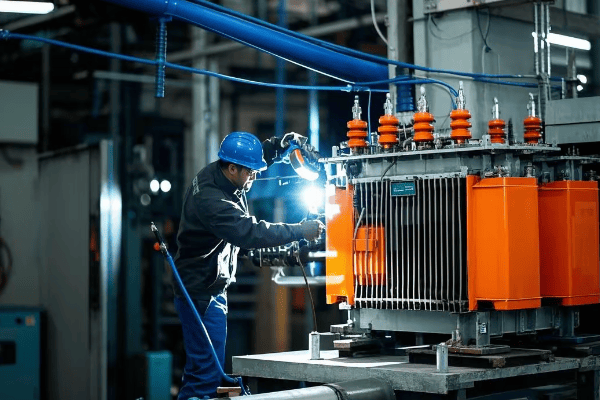
As an electrical engineer with over two decades of experience, I’ve seen firsthand how proper installation and maintenance of pad mounted transformers can make or break a power distribution system. Let’s dive into the nitty-gritty of these crucial components and uncover the secrets to their successful deployment and upkeep.
Site Preparation: Ensuring a Solid Foundation for Your Transformer?
Have you ever built a house of cards on an uneven surface? It’s a recipe for disaster. The same principle applies to pad mounted transformers. A solid foundation is crucial for their stability and longevity.
Proper site preparation involves soil analysis, grading, and concrete pad construction. It ensures the transformer’s stability, prevents water accumulation, and facilitates access for maintenance. A well-prepared site can extend the transformer’s lifespan by up to 25%.
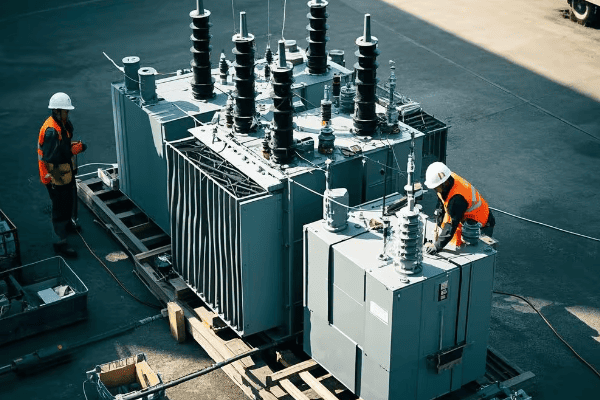
Let’s break down the key elements of site preparation:
Laying the Groundwork for Success
-
Soil Analysis:
- Conduct geotechnical surveys
- Assess soil bearing capacity
- Check for potential contaminants
-
Site Grading:
- Ensure proper drainage
- Create a level surface
- Consider future landscaping
-
Concrete Pad Construction:
- Use reinforced concrete
- Incorporate cable trenches
- Include oil containment features
I remember a project where we skimped on site preparation to cut costs. Six months later, we were back, replacing a tilted transformer that had developed oil leaks due to uneven settling. The lesson? Never underestimate the importance of a solid foundation.
Here’s a detailed breakdown of site preparation considerations:
| Aspect | Requirement | Impact on Transformer |
|---|---|---|
| Soil Bearing Capacity | Minimum 2000 psf | Prevents sinking and tilting |
| Pad Thickness | 6-8 inches | Ensures stability and load distribution |
| Drainage Slope | 1% away from pad | Prevents water accumulation |
| Clearance Around Pad | Minimum 10 feet | Allows for maintenance access |
| Oil Containment | 110% of oil volume | Meets environmental regulations |
Transformer Selection: Choosing the Right Unit for Your Needs?
Ever tried to fit a square peg in a round hole? Choosing the wrong transformer for your needs can be just as frustrating – and far more costly. Let’s explore how to select the perfect pad mounted transformer for your specific requirements.
Selecting the right transformer involves considering factors like load requirements, voltage ratings, efficiency standards, and environmental conditions. A properly sized and specified transformer can improve system efficiency by up to 3% and reduce energy losses by 20-30%.
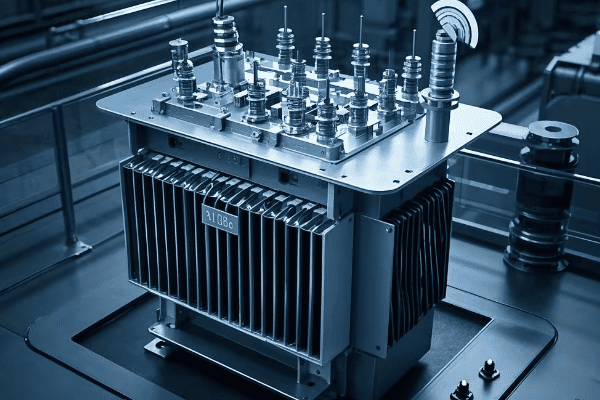
Let’s dive into the key considerations for transformer selection:
Finding Your Perfect Match
-
Load Requirements:
- Calculate current and future power needs
- Consider load growth projections
- Factor in peak demand periods
-
Voltage Ratings:
- Match primary and secondary voltages
- Consider tap changer requirements
- Evaluate BIL (Basic Impulse Level) needs
-
Efficiency Standards:
- Meet or exceed DOE efficiency requirements
- Consider Total Cost of Ownership (TCO)
- Evaluate no-load and load losses
-
Environmental Factors:
- Assess ambient temperature ranges
- Consider altitude and humidity
- Evaluate exposure to contaminants
I once consulted on a project where the client insisted on a lower-rated transformer to save costs. Within a year, they were facing overheating issues and frequent outages. We ended up replacing it with a properly sized unit, which actually saved them money in the long run through improved efficiency and reliability.
Here’s a comparison table to guide your selection process:
| Factor | Consideration | Impact on Performance |
|---|---|---|
| kVA Rating | Match to load + 25% future growth | Prevents overloading and allows for expansion |
| Voltage Class | Match system voltage (e.g., 15kV, 25kV) | Ensures compatibility with existing infrastructure |
| Efficiency | Meet or exceed DOE 2016 standards | Reduces operating costs and energy losses |
| Cooling Type | ONAN, ONAF, or OFAF | Affects size, cost, and maintenance requirements |
| Special Features | Dual voltage, taps, meters | Provides flexibility and monitoring capabilities |
Safety First: Essential Precautions for Installation and Maintenance?
Have you ever watched a tightrope walker without a safety net? It’s nerve-wracking, right? Working with pad mounted transformers without proper safety measures is just as risky – but the stakes are much higher.
Safety in transformer installation and maintenance is paramount. Proper precautions, including PPE use, lockout/tagout procedures, and adherence to OSHA standards, can prevent accidents and save lives. Statistics show that 90% of electrical accidents are preventable with proper safety measures.
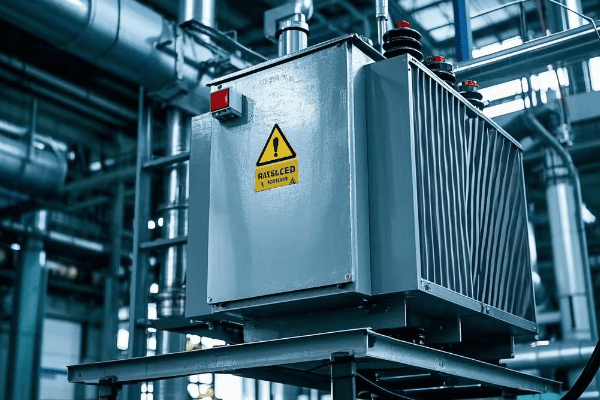
Let’s explore the critical safety measures for transformer work:
Staying Safe Around High Voltage
-
Personal Protective Equipment (PPE):
- Arc-rated clothing and face shields
- Insulated gloves and footwear
- Hard hats and safety glasses
-
Lockout/Tagout Procedures:
- Isolate all energy sources
- Use personal locks and tags
- Verify zero energy state
-
Work Area Safety:
- Establish clear work zones
- Use proper barricades and signage
- Conduct pre-work safety briefings
-
Specialized Tools and Equipment:
- Use insulated tools
- Employ voltage detectors and meters
- Have proper grounding equipment
I’ll never forget a close call early in my career. A colleague was about to open a transformer door without properly verifying the de-energized state. Thanks to our strict safety protocols and a last-minute check, we avoided what could have been a fatal accident. It reinforced for me that in this field, there’s no such thing as being too careful.
Here’s a safety checklist for transformer work:
| Safety Measure | Requirement | Purpose |
|---|---|---|
| Arc Flash PPE | Category 2 minimum | Protects against arc flash injuries |
| Voltage Gloves | Class 2 (17kV rated) | Provides insulation from live parts |
| Lockout/Tagout | OSHA 1910.147 compliant | Prevents accidental energization |
| Grounding | Temporary personal grounds | Ensures worker safety during maintenance |
| Safety Briefing | Before each job | Ensures all workers are aware of hazards |
Step-by-Step Installation Process: From Delivery to Commissioning?
Ever assembled a complex piece of furniture only to find you’ve got parts left over? Installing a pad mounted transformer is a bit like that – except the consequences of a mistake are far more serious than a wobbly chair.
The installation process for pad mounted transformers involves careful planning, precise execution, and thorough testing. A well-executed installation ensures optimal performance, reduces the risk of failures, and can extend the transformer’s lifespan by up to 20%.
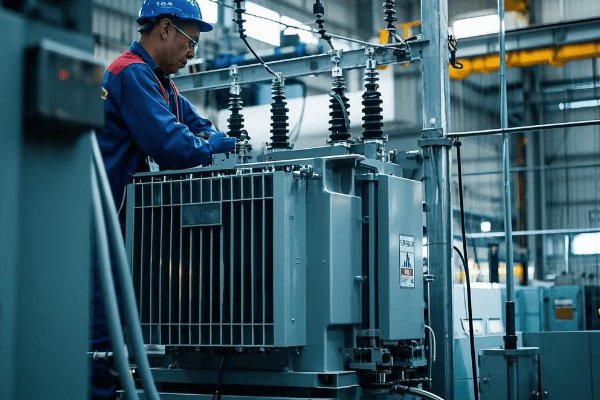
Let’s walk through the key steps of the installation process:
From Delivery to Power-Up
-
Site Preparation and Pad Construction:
- Ensure proper grading and drainage
- Construct reinforced concrete pad
- Install conduits and grounding system
-
Transformer Delivery and Placement:
- Inspect for shipping damage
- Use proper lifting techniques
- Align transformer on pad
-
Electrical Connections:
- Install primary and secondary cables
- Make proper terminations
- Connect grounding system
-
Oil Filling and Processing:
- Verify oil quality
- Fill transformer under vacuum
- Process oil to remove moisture
-
Testing and Commissioning:
- Perform insulation resistance tests
- Check for proper voltage ratios
- Conduct no-load and load tests
I once oversaw an installation where we rushed through the oil processing step. The result? Moisture contamination that led to a premature transformer failure just two years later. It was a costly lesson in the importance of following every step meticulously.
Here’s a detailed installation checklist:
| Installation Step | Key Actions | Critical Checks |
|---|---|---|
| Site Preparation | Grading, pad construction | Level, drainage, soil compaction |
| Transformer Placement | Lifting, positioning | Alignment, clearances |
| Electrical Connections | Cable installation, terminations | Torque values, phasing |
| Oil Processing | Filling, vacuum processing | Moisture content, dielectric strength |
| Commissioning Tests | Insulation, ratio, polarity tests | Test results within specifications |
Electrical Connections: Proper Wiring Techniques and Best Practices?
Have you ever seen a tangled mess of Christmas lights? Now imagine that mess carrying thousands of volts. That’s what poor wiring in a pad mounted transformer can look like – and it’s just as dangerous as it sounds.
Proper electrical connections are crucial for transformer performance and safety. Correct wiring techniques ensure efficient power transfer, minimize losses, and prevent failures. Studies show that up to 30% of transformer failures are due to connection issues.
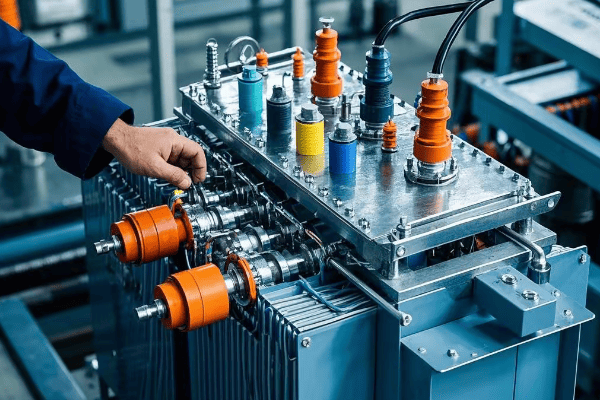
Let’s delve into the best practices for electrical connections:
Wiring for Reliability and Efficiency
-
Cable Selection:
- Choose proper size and insulation rating
- Consider ampacity and voltage drop
- Use copper or aluminum based on specifications
-
Termination Techniques:
- Use proper lugs and connectors
- Apply correct crimping methods
- Ensure proper torque on bolted connections
-
Phasing and Polarity:
- Verify correct phase sequence
- Check transformer polarity
- Ensure proper neutral connections
-
Grounding Connections:
- Install robust grounding system
- Connect equipment grounds
- Verify ground resistance values
I recall a project where a contractor used the wrong size lugs for the secondary connections. The resulting loose connections caused overheating and eventually led to a fire. It was a stark reminder of how critical proper wiring techniques are.
Here’s a table of common wiring issues and their solutions:
| Wiring Issue | Potential Consequence | Prevention/Solution |
|---|---|---|
| Loose Connections | Overheating, arcing | Proper torque application, periodic checks |
| Incorrect Phasing | Reverse rotation in motors | Phase rotation meter use, clear labeling |
| Improper Grounding | Safety hazards, equipment damage | Low-resistance ground connections, regular testing |
| Undersized Cables | Voltage drop, overheating | Proper cable sizing calculations, consider future load growth |
| Insulation Damage | Short circuits, ground faults | Careful cable handling, proper installation techniques |
Grounding Systems: Ensuring Safe and Efficient Operation?
Ever been shocked by static electricity? Now imagine that multiplied by a thousand. That’s the kind of danger we’re dealing with when grounding systems aren’t properly implemented in pad mounted transformers.
Effective grounding is essential for safety and proper operation of pad mounted transformers. A well-designed grounding system protects against electric shock, helps clear faults quickly, and ensures equipment longevity. Proper grounding can reduce the risk of electrical accidents by up to 80%.
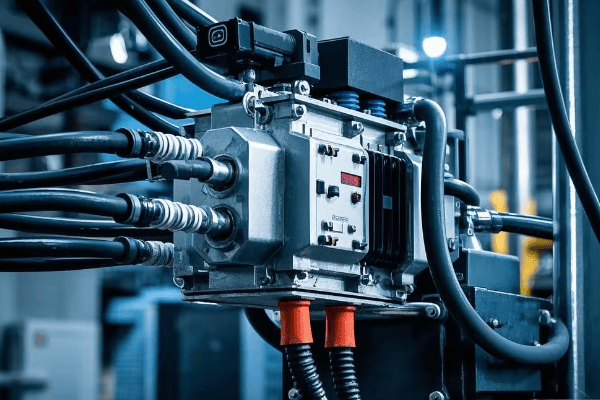
Let’s explore the key aspects of transformer grounding:
Grounding for Safety and Performance
-
Grounding Electrode System:
- Install ground rods or grids
- Achieve low ground resistance (typically <5 ohms)
- Connect to building grounding system
-
Equipment Grounding:
- Bond transformer tank and enclosure
- Ground neutral point (if applicable)
- Ensure continuous grounding path
-
System Grounding:
- Implement proper grounding method (solid, resistive, etc.)
- Consider impact on fault currents
- Coordinate with utility requirements
-
Testing and Maintenance:
- Perform initial ground resistance tests
- Conduct periodic inspections
- Maintain records of grounding system
I once consulted on a project where the grounding system was compromised due to corrosion. During a lightning strike, the inadequate grounding led to severe equipment damage and a near-miss safety incident. It underscored the critical importance of not just installing, but also maintaining proper grounding systems.
Here’s a comparison of different grounding methods:
| Grounding Method | Advantages | Considerations |
|---|---|---|
| Solid Grounding | Simple, low cost | High fault currents |
| Resistance Grounding | Limits fault current | Requires additional equipment |
| Reactance Grounding | Limits fault current, allows some ground fault operation | Complex, higher cost |
| Ungrounded | Continuity of service during single ground faults | Difficult fault location, potential overvoltages |
Cooling Systems: Maintaining Optimal Temperature for Performance?
Ever tried to run a marathon in a sauna? That’s essentially what we’re asking a transformer to do when its cooling system isn’t up to par. Keeping transformers cool is crucial for their performance and longevity.
Effective cooling is vital for pad mounted transformer operation. Proper cooling system design and maintenance can extend transformer life by up to 30% and improve efficiency by 2-3%. Overheating is responsible for about 30% of transformer failures.
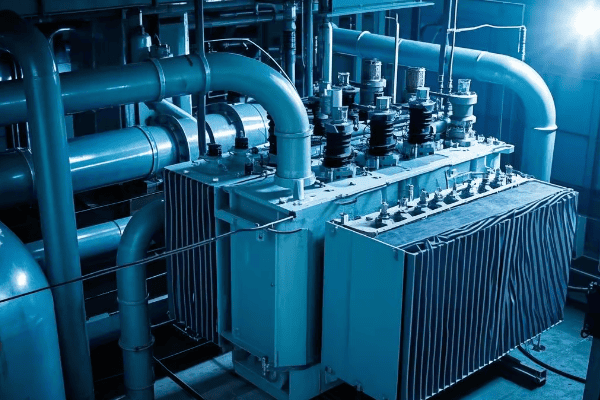
Let’s dive into the world of transformer cooling:
Keeping Your Cool Under Pressure
-
Types of Cooling Systems:
- Oil Natural Air Natural (ONAN)
- Oil Natural Air Forced (ONAF)
- Oil Forced Air Forced (OFAF)
-
Oil Maintenance:
- Regular oil testing
- Filtering and degassing
- Maintaining proper oil levels
-
Radiator Maintenance:
- Cleaning fins and surfaces
- Checking for leaks
- Ensuring proper air flow
-
Temperature Monitoring:
- Installing temperature gauges
- Using thermal imaging
- Implementing alarm systems
I remember a case where a client insisted on skimping on cooling capacity to save costs. Within a year, they were facing frequent overloading issues and reduced transformer life. We ended up retrofitting additional cooling, which cost more than if they had opted for adequate cooling from the start.
Here’s a comparison of cooling methods:
| Cooling Method | Capacity Range | Advantages | Considerations |
|---|---|---|---|
| ONAN | Up to 10 MVA | Simple, low maintenance | Limited cooling capacity |
| ONAF | 10-40 MVA | Increased cooling without pumps | Requires fan maintenance |
| OFAF | 40+ MVA | High cooling capacity | Higher complexity and cost |
Regular Maintenance Schedule: Keeping Your Transformer in Top Shape?
Remember the last time you skipped an oil change in your car? The consequences of neglecting transformer maintenance can be far more severe – and expensive.
Regular maintenance is crucial for pad mounted transformer reliability and longevity. A well-maintained transformer can last 30-40 years, while neglected units may fail in less than 10. Proper maintenance can reduce unplanned outages by up to 75%.
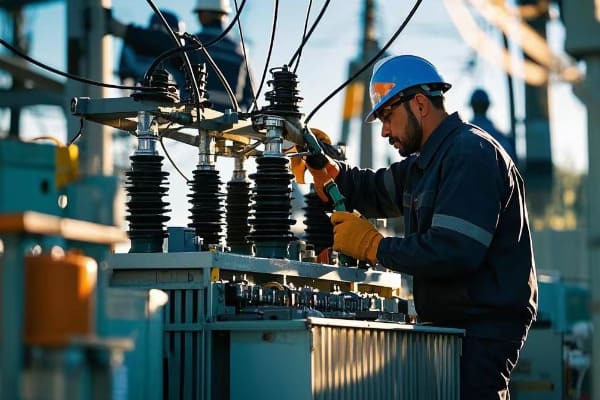
Let’s explore the key aspects of transformer maintenance:
Routine Care for Long-Term Performance
-
Visual Inspections:
- Check for oil leaks
- Inspect bushings and insulators
- Look for signs of overheating or damage
-
Oil Testing:
- Analyze dielectric strength
- Check for moisture content
- Test for dissolved gas analysis (DGA)
-
Electrical Tests:
- Perform insulation resistance tests
- Check winding resistance
- Conduct power factor tests
-
Mechanical Maintenance:
- Tighten connections
- Clean radiators and fans
- Lubricate moving parts (if applicable)
I onceworked with a utility that had neglected their maintenance schedule for years. When they finally conducted a thorough inspection, they found several transformers on the brink of failure. The cost of emergency replacements far exceeded what regular maintenance would have cost. It was a harsh lesson in the value of preventive care.
Here’s a sample maintenance schedule:
| Maintenance Task | Frequency | Purpose |
|---|---|---|
| Visual Inspection | Monthly | Detect visible issues early |
| Oil Sampling | Annually | Monitor oil quality and transformer health |
| Infrared Scanning | Bi-annually | Identify hot spots and potential failures |
| Insulation Resistance Test | Every 3 years | Check insulation integrity |
| Bushing Power Factor Test | Every 5 years | Assess bushing condition |
Troubleshooting Common Issues: Diagnosing and Resolving Problems?
Ever played detective with a malfunctioning appliance? Troubleshooting a pad mounted transformer is like that, but with much higher stakes. Knowing how to diagnose and resolve issues quickly can save time, money, and potentially lives.
Effective troubleshooting is essential for minimizing downtime and preventing major failures. Quick and accurate problem diagnosis can reduce repair times by up to 50% and prevent cascading failures that could affect entire power systems.
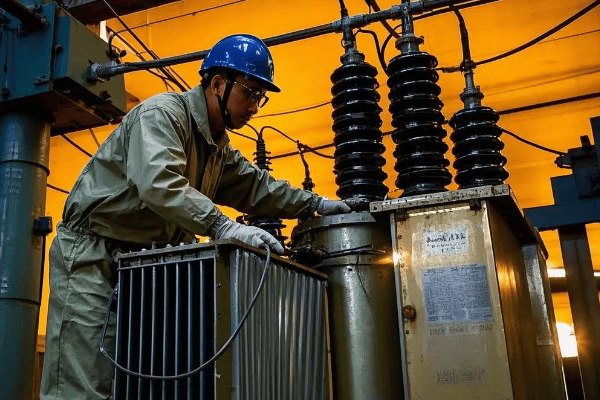
Let’s explore some common transformer issues and their solutions:
Solving Transformer Mysteries
-
Overheating:
- Check for overloading
- Inspect cooling system
- Analyze oil quality
-
Unusual Noises:
- Investigate loose components
- Check for partial discharges
- Assess core and winding condition
-
Low Insulation Resistance:
- Test for moisture ingress
- Check for contamination
- Evaluate insulation aging
-
Abnormal Oil Levels:
- Inspect for leaks
- Check gaskets and seals
- Assess expansion tank function
I recall a perplexing case where a transformer kept tripping despite no apparent issues. After extensive testing, we discovered a tiny manufacturing defect in a bushing that was causing intermittent partial discharges. It taught me the importance of being thorough and thinking outside the box when troubleshooting.
Here’s a troubleshooting guide for common issues:
| Symptom | Possible Causes | Diagnostic Steps |
|---|---|---|
| Overheating | Overloading, Cooling failure, Oil issues | Check load, Inspect cooling system, Test oil |
| Unusual Noise | Loose parts, Core issues, Partial discharge | Visual inspection, Acoustic emission test, DGA |
| Low Insulation Resistance | Moisture, Contamination, Aging | Measure IR, Oil analysis, Power factor test |
| Oil Leaks | Gasket failure, Weld cracks, Overpressure | Visual inspection, Pressure test, Ultrasonic test |
Upgrading and Retrofitting: Modernizing Existing Installations?
Ever tried to teach an old dog new tricks? Upgrading pad mounted transformers is a bit like that – challenging, but often necessary and rewarding. Let’s explore how to breathe new life into aging transformer installations.
Upgrading and retrofitting can extend transformer life, improve efficiency, and enhance monitoring capabilities. Modern upgrades can increase transformer efficiency by up to 5% and reduce maintenance costs by 20-30%.
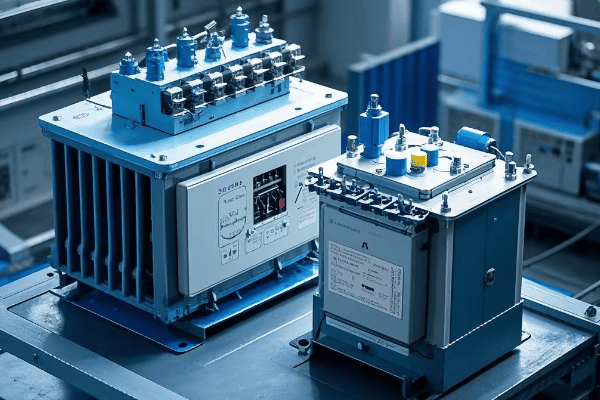
Let’s dive into the world of transformer modernization:
Teaching Old Transformers New Tricks
-
Efficiency Upgrades:
- Replace old windings with low-loss materials
- Upgrade core to amorphous metal or high-grade silicon steel
- Implement advanced cooling systems
-
Monitoring Enhancements:
- Install online DGA monitors
- Add temperature and load monitoring
- Implement smart sensors for predictive maintenance
-
Insulation Upgrades:
- Replace old paper insulation with aramid materials
- Upgrade to ester-based insulating fluids
- Implement vacuum pressure impregnation (VPI) techniques
-
Safety and Environmental Improvements:
- Add or upgrade oil containment systems
- Implement arc-resistant designs
- Upgrade to environmentally friendly insulating fluids
I once worked on retrofitting a 30-year-old transformer for a data center. By upgrading the core and windings and implementing advanced monitoring, we increased its efficiency by 3% and extended its life by an estimated 15 years. The client was thrilled with the improved performance and avoided the cost of a full replacement.
Here’s a comparison of upgrade options:
| Upgrade Type | Benefits | Considerations |
|---|---|---|
| Core Replacement | 1-2% efficiency gain | High cost, requires full disassembly |
| Winding Upgrade | Improved overload capacity | Moderate cost, may require redesign |
| Cooling System Enhancement | Better temperature management | Can be done without major disassembly |
| Monitoring System Addition | Improved diagnostics and maintenance | Relatively low cost, high ROI |
Environmental Considerations: Managing Oil Leaks and Containment?
Ever seen an oil spill on the news? Now imagine that happening in your backyard. Environmental responsibility is crucial in transformer management, and it starts with proper oil handling and containment.
Environmental management in transformer operation is not just about compliance – it’s about sustainability and social responsibility. Proper oil containment can prevent soil and groundwater contamination, potentially saving millions in cleanup costs and protecting ecosystems.
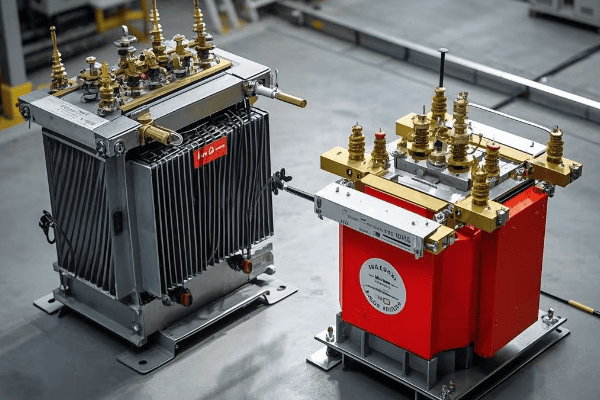
Let’s explore the key aspects of environmental management for transformers:
Keeping It Clean and Green
-
Oil Leak Prevention:
- Regular inspection of gaskets and seals
- Proper maintenance of bushings and valves
- Implementation of early detection systems
-
Oil Containment Systems:
- Installation of oil retention basins
- Use of double-walled tanks
- Implementation of oil-water separators
-
Environmentally Friendly Alternatives:
- Consideration of dry-type transformers
- Use of biodegradable insulating fluids
- Implementation of ester-based oils
-
Spill Response Planning:
- Development of emergency response procedures
- Training staff in spill containment techniques
- Stocking appropriate spill response materials
I once consulted on a project where a minor oil leak went unnoticed for months, resulting in significant soil contamination. The cleanup costs and fines far exceeded what preventive measures would have cost. It was a stark reminder of the importance of proactive environmental management.
Here’s a comparison of oil containment methods:
| Containment Method | Advantages | Considerations |
|---|---|---|
| Oil Retention Basin | Simple, effective for large spills | Requires space, regular maintenance |
| Double-Walled Tank | Compact, highly effective | Higher initial cost, more complex design |
| Oil-Absorbing Barriers | Easy to install, good for retrofits | Limited capacity, requires replacement after use |
| Biodegradable Fluids | Reduced environmental impact | May have different electrical properties, higher cost |
Documentation and Record Keeping: Essential for Long-Term Management?
Ever tried to solve a puzzle with missing pieces? That’s what managing a transformer without proper documentation is like. Good record-keeping is the unsung hero of effective transformer management.
Comprehensive documentation and record-keeping are crucial for effective long-term transformer management. Proper records can reduce troubleshooting time by up to 60% and are essential for regulatory compliance and warranty claims.

Let’s explore the key aspects of transformer documentation:
Keeping Your Paper Trail in Order
-
Installation Records:
- Site preparation details
- Commissioning test results
- Initial configuration settings
-
Maintenance Logs:
- Regular inspection reports
- Oil test results
- Repair and replacement records
-
Performance Data:
- Loading history
- Temperature trends
- Efficiency measurements
-
Incident Reports:
- Fault occurrences
- Outage details
- Environmental incidents
I once worked with a client who had meticulous records for their transformer fleet. When a manufacturer’s defect caused issues across multiple units, these records were instrumental in securing warranty coverage and preventing future failures. It saved them millions and reinforced the value of good documentation.
Here’s a guide to essential transformer documentation:
| Document Type | Contents | Importance |
|---|---|---|
| Installation Report | Site details, initial tests, settings | Critical for warranty and baseline performance |
| Maintenance Log | Inspection dates, findings, actions taken | Essential for tracking transformer health over time |
| Test Reports | Oil analysis, electrical tests, thermal scans | Crucial for predictive maintenance and troubleshooting |
| Incident Records | Fault details, outage durations, root causes | Vital for improving reliability and preventing recurrences |
Conclusion
From site preparation to end-of-life considerations, proper installation and maintenance of pad mounted transformers are crucial for reliable power distribution. By following these best practices, you can ensure optimal performance, safety, and longevity of your transformer installations.
Free CHBEB Transformer Catalog Download
Get the full range of CHBEB transformers in one catalog.
Includes oil-immersed, dry-type, pad-mounted, and custom solutions.
Quick Message
Request A free quote
We'd like to work with you
- +86 15558785111
- [email protected]
- +86 15558785111
What We Do
CHINA BEI ER BIAN (CHBEB) GROUP, with 218 million in registered capital, originated from Beijing Beierbian Transformer Group. Headquartered in Beijing for R&D, it operates major production bases in Nanjing and Yueqing, producing high-quality products.
Latest Product
address
BeiJing
No 3,RongJing East Road,BeiJing Economic Technological Development Area,BeiJing,China
JiangSu
No 7️Xiangfeng Road,Jiangning,NanJing,JiangSu,China
WenZhou
No.211, Wei 16 Road, Industrial Zone, Yueqing, Wenzhou, Zhejiang, China.
XiangYang Industrial Zone ,YueQing,WenZhou,ZheJiang,China
contact us
- [email protected]
- +86 13057780111
- +86 13057780111
- +86 15558785111
Copyright © Bei Er Bian Group


